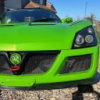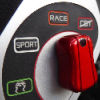Camber shims at the front are between the steering arm and the hub and changes to the camber will have virtually no effect on the toe. On the rear there's a tiny effect on the toe when you add or delete shims as the toe-link is attached separately to the bottom of the upright but in my experience it's quite small and you can safely experiment with different camber settings before checking and possibly adjusting the toe afterwards. It doesn't change that much that you run the risk of suddenly going toe-out at the back or anything. Bye, Arno.Can I change camber front and rear without affecting the toe?

Front Camber/toe In Settings
#21

Posted 01 June 2016 - 02:26 PM
#22

Posted 01 June 2016 - 05:41 PM
Fwd usually toe out at the front and toe out at the rear to help turnin and rotation (race fwd not road). Rwd is usually set to toe in on the front to increase stability, the front usually toe out to help turn in and pointyness.I always understood that on rear driven cars the front wheels had to be slightly toe in so that the tyre drag when moving pulls them back to parallel, conversly front drive cars should be toe out so that when under power they are pulled forward to parallel. Wouldn't the figures above lead to excessive toe out on a VX? Please explain someone.
Thanks for that. Couldn't quite work it out as all my road cars are as I've described but never bothered to see what the VX should be as it handles fine as is. When I was competing years ago in mid engine stuff we used to go for loads of negative camber and toe in on the back and some negative camber and parallel on the front then tweak by looking at the way the rubber was being dragged across the tread and trying to reduce that to get a clean tread. It's all more scientific now!
#23

Posted 01 June 2016 - 05:51 PM
well you should use temps really across the tyre to tell you what cambers you need.. ![]()
#24

Posted 01 June 2016 - 08:17 PM
What was that doofer you were using at Anglesey? Sent from my iPhone using Tapatalkwell you should use temps really across the tyre to tell you what cambers you need..

#25

Posted 01 June 2016 - 08:24 PM
laser temp gauge.
measured the surface temp of the tyres, which isn't ideal but you get a reasonable clue as to whats going on.
#26

Posted 01 June 2016 - 08:25 PM
well you should use temps really across the tyre to tell you what cambers you need..
Absolutely, but half a century ago that was just coming in, looking at how the rubber had smeared was the next best thing!
#27

Posted 02 June 2016 - 07:39 AM
depends on the construction of the tyre , camber for a 50 profile tyre may not work on a 45 profile or a 40 , plus different sidewall material and reinforcement etc.
I think the best move I made was to switch to a 9j wheel
#28

Posted 14 June 2016 - 11:10 AM
1 user(s) are reading this topic
0 members, 1 guests, 0 anonymous users
















